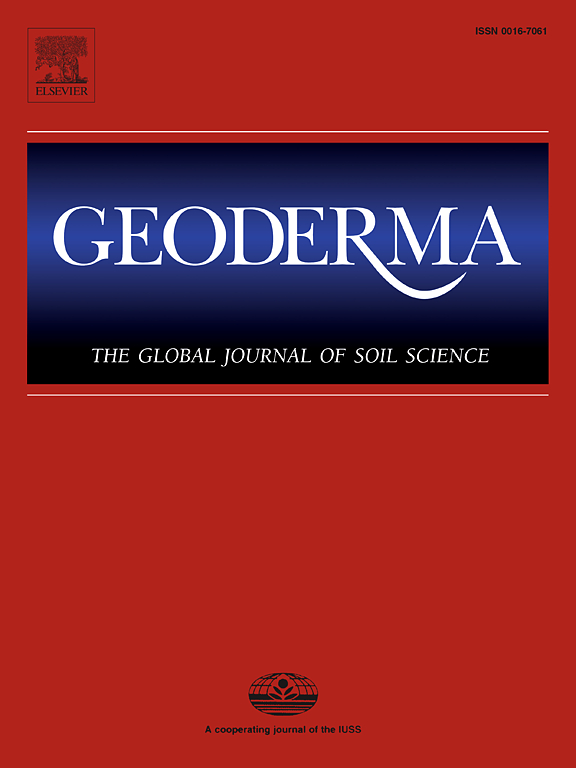在长期过量施肥的田间试验中,有机肥对土壤磷积累的影响有限
IF 6.6
1区 农林科学
Q1 SOIL SCIENCE
引用次数: 0
摘要
了解肥料磷(P)如何与土壤相互作用是必要的,以便有效地利用它。在长期田间试验至关重要(关闭农村-城市营养循环-通过农艺长期试验调查)中,有意过量施用有机肥以测试土壤生态毒理学极限。这使得每年的磷投入量高达463 kg·ha - 1,并保持了20多年的正磷平衡(作物收割后的投入量)。这些输入发生在砂壤土中。施肥处理包括污水污泥、堆肥、牛粪、其他有机肥和无机氮磷钾。我们假设,考虑到高磷肥料的投入,磷在表层土壤(0-0.2 m)的积累,以及其在顺序可提取部分的分布,将根据肥料中的磷含量而变化。我们测量了有机肥和表层土壤的磷组分和全磷浓度,并计算了两个磷预算。第一个预算将2003年的表层土壤全磷浓度与2022年的表层土壤全磷浓度进行了比较,考虑了这段时间的总肥料磷投入和作物产量。第二种是分数磷预算,它使用氮磷钾处理的表层土壤中的磷分数作为基线来评估施肥引起的变化。20年间,污泥、堆肥或粪肥处理的磷正平衡在2152 ~ 2664 kg·ha - 1之间。污泥或堆肥处理的表层土壤总磷储量至少增加了869 kg·ha - 1,而粪肥处理仅增加了278 kg·ha - 1。即使在磷已经饱和的表层土壤中,提供较少的树脂可提取磷和更多的NaHCO3-P或NaOH-P的处理也保留了较高比例的肥料磷。因此,特定有机肥导致土壤磷组分的增加,与它们自身的磷组分组成相对应。然而,在考虑作物磷素吸收后,施用过量磷的59 - 87%不能在表土中得到解释。因此,无论哪种肥料类型,过量施肥都会导致过量的磷从表土层移出,这对环境是有害的。本文章由计算机程序翻译,如有差异,请以英文原文为准。

Limited impact of organic fertilizers on soil phosphorus accumulation in a long-term field experiment with excess fertilization
Understanding how fertilizer phosphorus (P) interacts with soils is necessary in order to use it efficiently. In the long-term field experiment CRUCIAL (Closing the Rural-Urban Nutrient Cycle − Investigations through Agronomic Long-term experiments), organic fertilizers were intentionally overapplied to test soil ecotoxicological limits. This has resulted in yearly P inputs of up to 463 kg·ha−1 and positive P balances (input after crop offtake) for over 20 years. These inputs have occurred in sandy loam soils. Fertilization treatments included sewage sludge, compost, cattle manure, other organic fertilizers, and mineral NPK. We hypothesized that, given the high fertilizer P inputs, P accumulation in the topsoil (0–0.2 m), along with its distribution into sequentially extractable fractions, would vary depending on P fractions in the fertilizers. We measured P fractions and total P concentrations in both organic fertilizers and topsoils, and calculated two P budgets. The first budget compared topsoil total P concentrations from 2003 with those from 2022, considering the total fertilizer P inputs and crop offtake over that time. The second is a fractional P budget that uses P fractions in topsoils treated with NPK as a baseline to assess fertilization induced changes. Treatments with sludge, compost, or manure had positive P balances between 2152 and 2664 kg·ha−1 over 20 years. Total P stocks in the topsoil increased by at least 869 kg·ha−1 in treatments with sludge or compost compared to only 278 kg·ha−1 with manure. Treatments supplying less resin extractable-P and more NaHCO3-P or NaOH-P retained a higher proportion of the fertilizer P, even in topsoils already saturated with P. Consequently, specific organic fertilizers have caused increases in soil P fractions corresponding to their own P fraction compositions. Still, between 59–87 % of the excess P applied could not be accounted for in topsoils after considering crop P offtake. Consequently, regardless of the fertilizer type, overfertilization led to excess P movement out of the topsoil layer, which is detrimental for the environment.
求助全文
通过发布文献求助,成功后即可免费获取论文全文。
去求助
来源期刊

Geoderma
农林科学-土壤科学
CiteScore
11.80
自引率
6.60%
发文量
597
审稿时长
58 days
期刊介绍:
Geoderma - the global journal of soil science - welcomes authors, readers and soil research from all parts of the world, encourages worldwide soil studies, and embraces all aspects of soil science and its associated pedagogy. The journal particularly welcomes interdisciplinary work focusing on dynamic soil processes and functions across space and time.
 求助内容:
求助内容: 应助结果提醒方式:
应助结果提醒方式:


